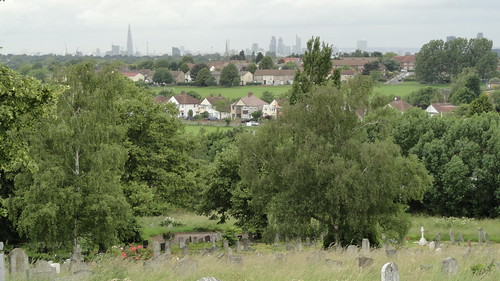Then I remember the story about Christopher Lloyd, one of the - if not The - greatest plantsmen of the 20th century. If he was visiting a garden and encountered a plant that was unfamiliar to him, he'd nudge it with his toe and nonchalantly ask his host, "What are they calling this these days", a cheeky reference to the fact that taxonomists are constantly changing plant names and a brilliant way to mask his extraordinarily rare ignorance. Unfortunately that trick doesn't work when you're the one being asked and you don't know the answer.
So there I was at work - in a garden that's still new to me and that I'm still getting to know - when a guest asked me, "What's that plant?" and pointed to a variegated ground cover with seed heads that clearly mark it a member of the Umbelliferae, which the taxonomists have changed to Apiaceae (see, Mr. Lloyd was really onto something). This puts it in the same family as carrots and Queen Anne's Lace but I recognized it as neither of those. Whatever it was, it was happily colonizing a small space under an apple tree and doing a splendid job of crowding out the Sarcococca*.
After this cursory and incomplete identification, the guest went to her lunch and I went about the rest of my day, temporarily forgetting about the Mystery Plant. Until five o'clock this morning, when I reluctantly awoke from a very pleasant dream with "variegated umbellifer" in my mind and couldn't get it out (we plant geeks obviously have very strange cognitive functions).
You'll be happy to know, then, that the plant in question is a variegated form of Aegopodium podagraria, commonly called Gout Weed** and it's Number 1 on Canada's 10 Most Unwanted List. Introduced to America from Europe and Russian Asia, it was known in those parts as a medicinal and pot (culinary) herb back in the Middle Ages where it was used to treat gout. The 16th century herbalist John Gerard described the thuggish habit I observed thusly:
'Herbe Gerard groweth of itself in gardens without setting or sowing and is so fruitful in its increase that when it hath once taken roote, it will hardly be gotten out againe, spoiling and getting every yeare more ground, to the annoying of better herbe.'
I didn't ask the Sarcococca if it was annoyed, but it sure looks it.
Its botanical name is derived from the Greek words “agios” meaning goat and “podion” which means little foot, combined to "Little Goat Foot" because the shape of the leaf is thought to resemble the shape of a goat’s foot.
Another of its names, Bishop's Weed,*** comes from it's being commonly found near monastic ruins. Monks grew and traded medicinal plants, they being practically the only persons who could travel extensively in the Middle Ages without much fear of being set upon by highwaymen. Saint Gerard lent his name to the plant, as well, being the lucky saint invoked to cure the gout. The roots and leaves have diuretic properties and were boiled or crushed then applied as a poultice, or eaten in a bitter spring salad. It's also thought to be helpful in alleviating symptoms of rheumatism, kidney, bladder, and intestinal disorders, and hemorrhoids (not sure how they discovered that one).
All in all a very useful addition to the early physic garden and the variegation makes this variety a very decorative plant, but it's ruffian personality dictates a ruthless hand in controlling its spread both in the garden and in the wild. It spreads by underground rhizomes and by seed, so cutting off the flower stalks immediately after blooming and pulling it out roots and all are the best control methods. The variegated leaves do make a nice ground cover in an area of dappled shade so long as it's kept in bounds.
Now armed with this bit of information, I'll be ready the next time someone asks me what it is. I might even give it a nudge with my toe and say, "This one? Well, in the Middle Ages it was known by a whole list of names but these days they call it something completely different..."
*Sarcococca hookeriana: also called Sweet Box, makes a nice groundcover. Leaves are deep glossy green in shade with clusters of fragrant white flowers in late winter and early spring.
**Other names include: Ground Ash, Ashweed, Pot Ash, White Ash, Ground Elder, Dog Elder, Dwarf Elder, Garden Plague, Farmer’s Plague, Snow-on-the-Mountain, Jack Jumpabout, Jump About, Goat’s Foot, Bull Wort, Bishop Wort, Bishop Weed, Herb William and Herb Gerard (whew!)
***Not to be confused with another member of the Apiaceae also called Bishop's Weed for similar reasons, Ammi majus, seen here used to great effect in the garden at Great Dixter.
 |
| (greatdixter.co.uk) |








